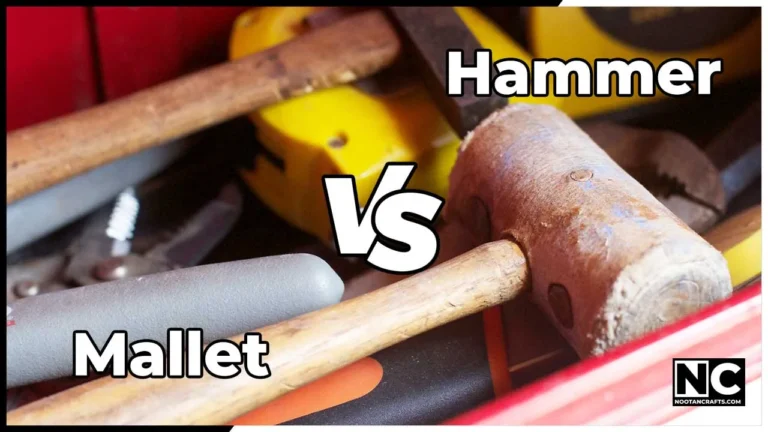Is a mallet or hammer the same thing? Why do we need a mallet? When should we use a mallet or a hammer? Many questions come into mind when we talk about mallet vs hammer, so let’s get started!
When I started my DIY journey, I wasn’t aware of a mallet; a hammer was my everyday tool, whether working with metal or any softer materials such as wood, plywood, or plastic. However, I always put a wooden plank on a softer material to avoid damage before hitting it with a hammer.
My top recommendation!
- Durable rubber mallet hammer head for soft blow strike that doesn’t damage
- Extra strength fiberglass handle with shock absorption design
- Ergonomic non slip rubber grip
Last update on 2025-03-27 / Affiliate links / Images from Amazon Product Advertising API
You might find it funny that I had a mugdar, which I re-purposed as a mallet. A mugdar is a traditional Indian mace or club used for exercise, self-defense, and ceremonial purposes. However, that’s not a perfect replacement for a mallet, but it served my purpose many times.
In this article, you will learn the key differences between mallets and hammers, their uses, and which one you should choose.
Let’s understand each individually before we delve into the discussion of mallet vs hammer.
What Is a Mallet?
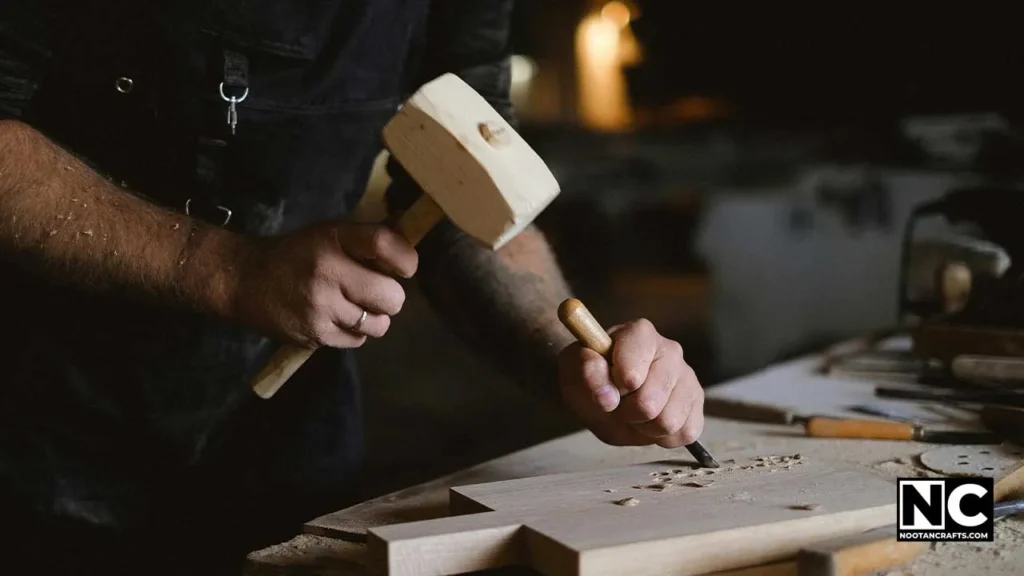
A mallet has a large cylindrical head and is often made of softer rubber, wood, or plastic. It is designed to avoid damaging the surface, so it is perfect for more delicate tasks, especially when you don’t want to leave marks or damage.
You might have seen mallets used in woodworking, leatherworking, furniture assembly, or tile laying. Due to its large and soft head, a mallet can deliver force without a sharp, potentially damaging impact, which is the true beauty of this tool. A mallet is a trusted buddy of a chisel—I learned this the hard way when I bent and damaged my chisel with a hammer.
Common Material Use in Mallets:
- Wood (for woodworking mallets)
- Rubber (often used when working with soft materials)
- Plastic (for certain DIY tasks where a softer touch is needed)
Typical Uses:
- Shaping wood without splintering
- Working with soft materials like leather or plastic
- Assembling pieces of furniture where you need a non-marking strike
- Gentle tapping to set up mortar firmly while laying marble and tiles
What Is a Hammer?
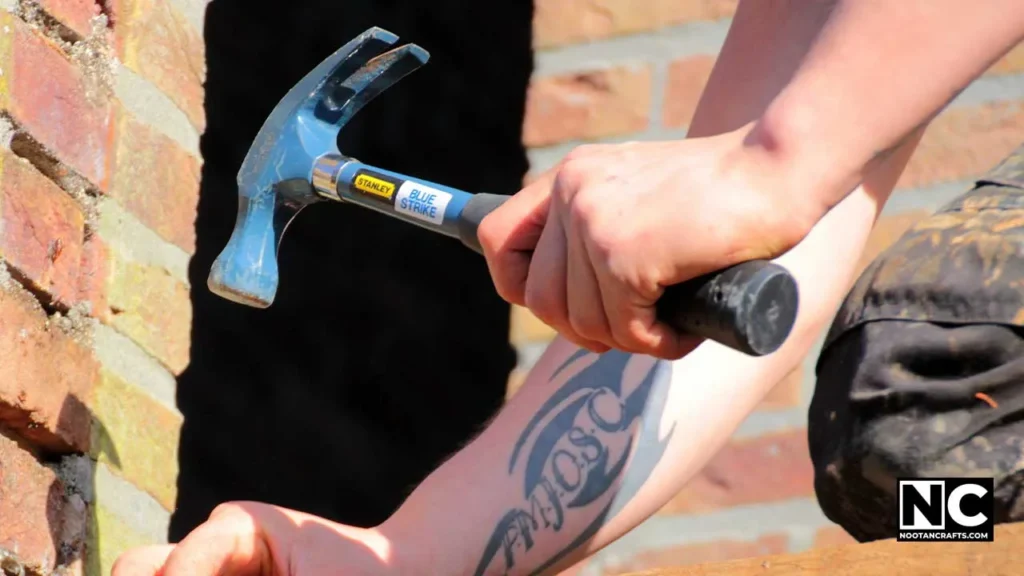
Now, a hammer is the heavier-duty cousin of the mallet who deals with tough stuff. It’s the tool you reach for when you need to drive nails, break something apart, or apply a lot of force in one hit. A hammer usually has a smaller metal head (usually steel), resulting in a more focused striking area. If you’re in construction, you’ll probably have a hammer in hand all day long.
When we think of a “hammer,” we usually picture a classic claw hammer — it drives nails in with one side and pulls them out with the other. But there are many types of hammers, each designed for a specific job, such as a ball-peen hammer for metalworking and an intimidating sledgehammer for demolition.
I’ve lost count of how many times I’ve accidentally hit my thumb with a hammer (yeah, that’s another thing to look out for), but once you master its force, it’s an indispensable tool.
Types of Hammers:
- Claw hammer (for driving and pulling nails)
- Ball-peen hammer (for metalworking tasks)
- Sledgehammer (for heavy-duty demolition)
Typical Uses:
- Driving nails into wood
- Demolition work
- Shaping or breaking metal
Now that you know the basics of a hammer and mallet, let’s understand their key differences.
Mallet vs Hammer – Key Differences
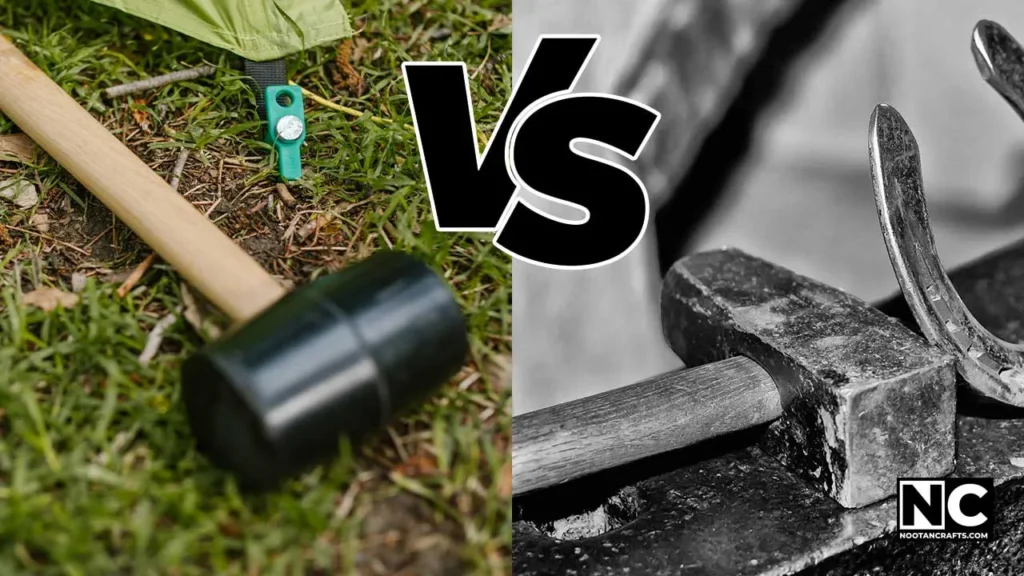
Alright, so what’s the big deal? Why not just use a hammer for everything? Well, let me break it down. The critical difference between a mallet and a hammer lies in the head material and the force applied. A mallet has a softer head, so it’s great for precision work where you want to avoid damage. In contrast, a hammer is all about brute force and high-impact hits.
Mallet vs Hammer – Impact & Surface Differences
- Because of its bigger head, a mallet distributes force over a larger, softer surface, making it perfect for non-marking strikes.
- A hammer focuses all its energy on a smaller point, ideal for tasks like driving nails but not so much for delicate work.
Materials They Work Best With:
- Mallets are ideal for softer materials like wood, leather, or plastic, where precision matters.
- Hammers are designed for more rigid materials like metal, stone, or hardwood.
Here’s a simple table highlighting the key differences between a mallet and a hammer:
| Feature | Mallet | Hammer |
| Head Material | Wood, rubber, or plastic | Steel or metal |
| Impact Force | Soft, even strikes | Hard, high-impact strikes |
| Precision | High, minimal surface damage | Low, can damage softer materials |
| Best For | Woodworking, delicate tasks | Driving nails, demolition, metalworking |
| Common Uses | Shaping wood, assembling furniture | Driving nails, breaking apart materials |
| Surface Marks | Non-marking | Can leave dents or damage |
| Ideal Materials | Soft materials (wood, leather, plastic) | Hard materials (wood, metal, concrete) |
| Tool Size | Typically larger, softer head | Smaller, harder head |
| Versatility | Less versatile, more specialized | Highly versatile across various tasks |
When to Use a Mallet
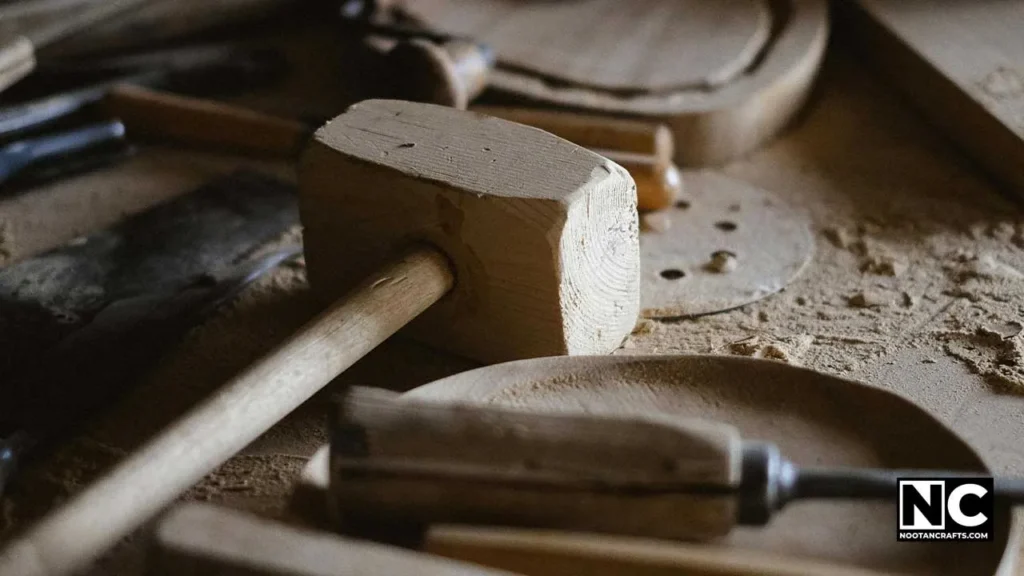
So, when should you reach for a mallet instead of a hammer? A mallet is your best friend if you need to shape something without leaving any dents or marks. This is especially true for woodworking. I learned this the hard way when trying to tap a wooden dowel into place with a hammer—one wrong swing, and there was a big dent where I didn’t want it. After that, I switched to using a wooden mallet, and that’s when I discovered my wooden mugdar, which I used as a mallet for a few years.
Best Situations for Mallet Use:
- Woodworking projects where you need to tap pieces together without damaging them
- When chiseling, to control the depth and precision of each cut
- Assembling furniture or working with materials that dent easily
- Some professionals use mallets for metal work to shape thin sheets or repair automobile body
Common Mistakes When Using a Mallet:
- Using a mallet for heavy-duty tasks like driving large nails—this is a job for a hammer. It may damage the mallet!
- Not matching the mallet material to the job (e.g., using a rubber mallet for wood when a wooden mallet would be more effective)
When to Use a Hammer

Now, hammers are a different beast. If you need to get something done that involves a lot of force, like driving nails into hardwood, breaking something apart, or even light demolition—a hammer is a tool for you. I often use a claw hammer for DIY projects, especially when I need to drive nails into place quickly or bend a metal strip. But there’s something satisfying about using a ball-peen hammer when shaping metal—it’s like the hammer and the metal understand each other.
Best Situations for Hammer Use:
- Driving nails into wood, drywall, or even concrete (with the right type of hammer)
- Breaking down materials during a demolition project
- Metalworking, especially shaping or flattening metal
Common Mistakes When Using a Hammer:
- Using too much force when it’s not needed can result in bent nails or damaged materials
- Choosing the wrong type of hammer for the job (e.g., using a ball-peen hammer for demolition—it’s not built for that)
General FAQs
1. Can I use a mallet instead of a hammer?
Yes, but only for specific tasks. Mallets are better for delicate work, while hammers are designed for high-impact tasks like driving nails.
2. What is the main difference between a mallet and a hammer?
A mallet has a softer and larger head made of wood or rubber, while a hammer has a smaller and harder metal head, making it more suitable for heavy-duty work.
3. Which tool is best for woodworking?
A mallet is generally better for woodworking because it minimizes the material’s damaging risk.
4. Can a hammer damage materials?
Yes, hammers can easily dent or damage softer materials, so you should use a mallet for more delicate tasks.
5. Are mallets and hammers interchangeable?
No, each tool has its strengths. A mallet is ideal for precision work, while a hammer is suited for high-impact tasks.
Conclusion:
Ultimately, whether you reach for a mallet or a hammer depends on the specific job you’re tackling. Mallets are great for precision and working with softer materials, while hammers offer the brute force needed for heavier tasks. Understanding the differences between mallet and hammer can make all the difference in your DIY projects. So next time you’re unsure, think about the material and the desired result—and choose wisely! Have you got more tips or stories? Please share them with us in the comments! Until next time, keep crafting!

 How to Guides
How to Guides Woodworking Techniques
Woodworking Techniques
